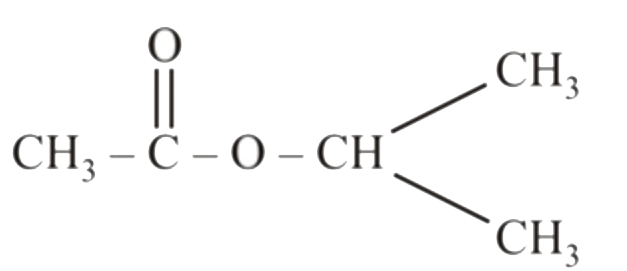Sodium salt of acetic acid reacts with ethyl iodide to give

The correct Answer is:B
To solve the question of what product is formed when sodium salt of acetic acid reacts with ethyl iodide, we can follow these steps:
Step 1: Identify the Reactants
The reactants are:
- Sodium salt of acetic acid (sodium acetate, CH₃COONa)
- Ethyl iodide (C₂H₅I)
Step 2: Understand the Structure of Sodium Acetate
Sodium acetate can be represented as:
- CH₃COO⁻ Na⁺
This indicates that the acetate ion (CH₃COO⁻) has a negative charge.
Step 3: Recognize the Nucleophilic Nature of Acetate Ion
The acetate ion (CH₃COO⁻) acts as a nucleophile due to its negative charge. It can attack electrophilic centers.
Step 4: Identify the Electrophilic Center in Ethyl Iodide
In ethyl iodide (C₂H₅I), the carbon atom bonded to iodine is electrophilic because iodine is more electronegative and pulls electron density away from the carbon, making it partially positive.
Step 5: Nucleophilic Attack
The acetate ion (CH₃COO⁻) will attack the electrophilic carbon in ethyl iodide (C₂H₅I). The reaction can be represented as:
- CH₃COO⁻ + C₂H₅I → CH₃COC₂H₅ + I⁻
Step 6: Formation of the Product
The product formed from this reaction is ethyl acetate (CH₃COC₂H₅) and iodide ion (I⁻) as a leaving group.
Conclusion
Thus, the final product of the reaction between sodium salt of acetic acid and ethyl iodide is ethyl acetate (CH₃COC₂H₅).
---
The reactants are:
- Sodium salt of acetic acid (sodium acetate, CH₃COONa)
- Ethyl iodide (C₂H₅I)
Sodium acetate can be represented as:
- CH₃COO⁻ Na⁺
This indicates that the acetate ion (CH₃COO⁻) has a negative charge.
The acetate ion (CH₃COO⁻) acts as a nucleophile due to its negative charge. It can attack electrophilic centers.
In ethyl iodide (C₂H₅I), the carbon atom bonded to iodine is electrophilic because iodine is more electronegative and pulls electron density away from the carbon, making it partially positive.
The acetate ion (CH₃COO⁻) will attack the electrophilic carbon in ethyl iodide (C₂H₅I). The reaction can be represented as:
- CH₃COO⁻ + C₂H₅I → CH₃COC₂H₅ + I⁻
The product formed from this reaction is ethyl acetate (CH₃COC₂H₅) and iodide ion (I⁻) as a leaving group.
Thus, the final product of the reaction between sodium salt of acetic acid and ethyl iodide is ethyl acetate (CH₃COC₂H₅).
Topper's Solved these Questions
Similar Questions
Knowledge Check
Silver salt of acetic acid heated with ethyl iodide gives
AMethyl acetateBEthyl formateCEthyl acetateDMethyl formateSodium acetate reacts with acetyl chloride to give
Aacetic acidBacetic anhydrideCmethyl acetateDethyl acetateAcetic acid react with PCl5 gives ,
ACH3COClBClCH2CH2ClCCH3COOClDCH3Cl
In the presence of concentrated sulphuric acid, acetic acid reacts with ethyl alcohol to produce
View SolutionEthyl amine reacts with excess of methyl iodide to give
View Solution23 g of sodium will react with ethyl alcohol to give:
View Solution23 g of sodium will react with ethyl alcohol to give
View SolutionSodium phenoxide is reacted with ethyl chloride gives
View Solution
